| Article ID | Journal | Published Year | Pages | File Type |
|---|---|---|---|---|
| 5787654 | Engineering Geology | 2017 | 9 Pages |
Abstract
Focusing on the deficiencies of the current liquefaction evaluation methods typically on deep sandy-layers of 10Â m to 20Â m, a new liquefaction evaluation formula, which is based on the 156 SPT data from liquefaction investigation in China mainland, is proposed. The formula is plausible for wide depth range up to 20Â m. The formula which takes a hyperbolic function form fits the liquefaction data at shallow depth and predicts satisfactorily deep liquefaction. The liquefaction dataset available from China earthquakes and foreign earthquakes (i.e., Kobe earthquake and ChiChi earthquake) are statistically summarized. The deficiencies of prevailing liquefaction evaluation methods and the CSR method by Seed are pinpointed. To validate the proposed formula, a liquefaction dataset consist of 312 liquefaction data from China mainland and foreign countries is used for re-evaluation. The results indicate that the new formula is quite feasible for wide sandy-layer buried depth, different seismic intensities and varying groundwater tables. Comparing with the current Chinese code methods and the CSR method, the new formula which approaches to an asymptote eliminates the abnormality of the CSR method that decreases inversely when the depth exceeds a certain value. The new formulae solve the deficiency of Chinese codified liquefaction evaluation methods that are conservative for intensity VII at shallow depth <Â 10Â m, and evenly predict liquefaction superior to the Chinese code methods for intensities VIII and IX at shallow depth. The new formula overcomes the considerably conservative predictions of the code methods on deep soil of 10Â m to 20Â m in intensities VIII and IX.
Related Topics
Physical Sciences and Engineering
Earth and Planetary Sciences
Geotechnical Engineering and Engineering Geology
Authors
Yang Yang, Longwei Chen, Rui Sun, Yongxiang Chen, Weiming Wang,
